Tuesday, December 20, 2005
Tuesday, December 13, 2005
Thursday, December 01, 2005
Thanksgiving in Lake Chelan (11/24-27)
Stayed at Wapato Point. Snowed heavily on 11/25, and made everything a lot prettier. Didn't do much, ate, read, played cards and watched videos. Went snow shoeing on 11/26 and picked some apples on the way back. The snow didn't melt when we left. On the way home to Seattle, we stopped by Leavenworth.
Stayed at Wapato Point. Snowed heavily on 11/25, and made everything a lot prettier. Didn't do much, ate, read, played cards and watched videos. Went snow shoeing on 11/26 and picked some apples on the way back. The snow didn't melt when we left. On the way home to Seattle, we stopped by Leavenworth.
Friday, November 18, 2005
Friday, November 11, 2005
2005.11.10. Seattle Symphony. Conducted by Jun Märkl.
- Gabriela Lena Frank: Manchay Tiempo
- Beethoven: Piano Concerto No. 1 in C major, Op. 15
- Brahms: Symphony No. 1 in C minor, Op. 15
Tuesday, November 08, 2005
Friday, November 04, 2005
2005.11.1 Sweeney Todd at the 5th Ave Theater. Music and Lyrics by Stephen Sondheim. Very timely performance. Quite funny for the morbid subject. Carol Swarbrick who played Mrs Lovett, the meat pie maker, is awesome.
Monday, October 24, 2005
2005.10.22. Museum of Glass at Tacoma. There's an exhibition of Paul Stankard's floral paper weights. Flowers completed with stigmas, leaves with veins, entangled roots, sometimes accompanied by bees with paper-thin wings. Exquisite. However some of the designs are too crowded. We also watched his demonstration. He talks a lot, tries to philosophy everything.
Went to Seattle Symphony's performance at 8pm. Another excellent concert. Soloist is Viviane Hagner. Beautiful playing and presence. Program is:
Went to Seattle Symphony's performance at 8pm. Another excellent concert. Soloist is Viviane Hagner. Beautiful playing and presence. Program is:
- Mozart: Overture to La clemenza di Tito, K.621
- Mozart: Violin Concerto No. 3 in G major, K.216
- Beethoven: Violin Romance No. 2 in F major, Op. 50
- Beethoven: Symphony No. 1 in C major, Op. 21
King Stag 2005.10.20. A new play by Seattle Repertory Theater. A disappointment. They tried to involve the audience in the play, which was done reasonably well. However, stupid dialogs, simple stage design. Completely different style from last year. Just learned that they have a new artistic director. I guess I won't be coming here any more.
Tuesday, October 18, 2005
the End of the Affair 2005.10.15. Seattle Opera.
Composed by Jake Higgies, libretto by Heather McDonald, based on novel by Graham Greene.
No chorus. A couple of quartets, pretty nice. The music is not very memorable. The foxtrot at the beginning and end of the opera seems to come from somewhere. I like the singers (except for the mother figure. I think she can be deleted. Her voice is coarse too.), Mary Mills for Sarah, Brett Polegato for Henry the husband, Philip Cutlip for Maurice the lover. Interesting to have the two leading voices in baritone. The stage design is not bad, however, it looks more like some town in France or Italy than London. Overall, a good attempt.
Composed by Jake Higgies, libretto by Heather McDonald, based on novel by Graham Greene.
No chorus. A couple of quartets, pretty nice. The music is not very memorable. The foxtrot at the beginning and end of the opera seems to come from somewhere. I like the singers (except for the mother figure. I think she can be deleted. Her voice is coarse too.), Mary Mills for Sarah, Brett Polegato for Henry the husband, Philip Cutlip for Maurice the lover. Interesting to have the two leading voices in baritone. The stage design is not bad, however, it looks more like some town in France or Italy than London. Overall, a good attempt.
Sunday, October 09, 2005
2005.10.9. Heather Lake. 3.8 miles R/T, ~900 ft gain.
Direction: east of Verlot station, turn right as soon as crossing the bridge.
Drizzle at times. Beautiful lake. Green->yellow bamboo-like weed fill the edge of the lake. Quite a few trickles on the cliff.
Direction: east of Verlot station, turn right as soon as crossing the bridge.
Drizzle at times. Beautiful lake. Green->yellow bamboo-like weed fill the edge of the lake. Quite a few trickles on the cliff.
Wednesday, September 28, 2005
King and I, 9/27/2005
The night I returned from China, I went to see this musical at the 5th Ave Theater despite of fatigue.
Very similar to the original movie. Well done, but nothing new.
The night I returned from China, I went to see this musical at the 5th Ave Theater despite of fatigue.
Very similar to the original movie. Well done, but nothing new.
Tuesday, September 27, 2005
China part 6 of 6: Emei Mountain 峨眉山 and Leshan Buddha 乐山大佛 (9/21-22)
This can be a trip of Buddhism education. 峨眉山 is one of the four major pilgrimage destinations, dedicated to Samantabhadra 普贤菩萨, the Buddha of truth and peace, (together with Putuo Mountain 普陀山 in Zhejiang 浙江 province for Avalokitesvara 观音菩萨, the Buddha of compassion; Wutai Mountain 五台山 in Shanxi 山西 for Manjusri 文殊菩萨, the Buddha of wisdom; Jiuhua Mountain 九华山 in Anhui 安徽 for Ksitigarbha 地藏菩萨, the Buddha of protection).
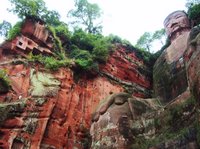 The city of Leshan 乐山 is about 70Km south of Chengdu 成都. The Grand Buddha was sculptured (713-803 AD) out of the cliff 凌云山 at the confluence of three Rivers: 岷江, 大渡河, 青衣江, in order to protect the boats and their passengers. At 71m tall, with two 7m long ears and 8m wide feet, it's considered as the world's largest. Originally it had 13 stories of wooden worshiping temple. Long disappeared. The ancient walkway still exists on both sides of him (one way traffic now). Thousands of people queue up in order to walk down and admire his entire image. The wait can be 30 min - 1 hour. From the gate (¥70, half for students and seniors) to the top of the hill is quite pleasant (if not crowded). At the top, before and after your queue for the Buddha, you can pause at many tea houses and old pavilions. Our guide spent almost 2 hours on the procedures of the blessing ceremonies 开光 being taken place at Emei Mountain 峨眉山 (once every few years), and encouraged everyone to attend and purchase proper items to be blessed.
The city of Leshan 乐山 is about 70Km south of Chengdu 成都. The Grand Buddha was sculptured (713-803 AD) out of the cliff 凌云山 at the confluence of three Rivers: 岷江, 大渡河, 青衣江, in order to protect the boats and their passengers. At 71m tall, with two 7m long ears and 8m wide feet, it's considered as the world's largest. Originally it had 13 stories of wooden worshiping temple. Long disappeared. The ancient walkway still exists on both sides of him (one way traffic now). Thousands of people queue up in order to walk down and admire his entire image. The wait can be 30 min - 1 hour. From the gate (¥70, half for students and seniors) to the top of the hill is quite pleasant (if not crowded). At the top, before and after your queue for the Buddha, you can pause at many tea houses and old pavilions. Our guide spent almost 2 hours on the procedures of the blessing ceremonies 开光 being taken place at Emei Mountain 峨眉山 (once every few years), and encouraged everyone to attend and purchase proper items to be blessed.
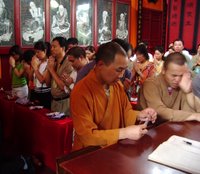 The next day, 峨眉山 (¥120, half for students and seniors). ¥60 bus goes from the gate 报国寺 to the cable car terminal. After the lift ¥40, we reached the main worship spot, Wannian Temple 万年寺, halfway up the slope. Many of our fellow tourist applied for blessing here. It was a "mass production". Every session took around 10 minutes, about 30 people at a time. The monk walked by everyone chanting, sprinkled water at the object to be blessed and the head of the believers. At the side, a row of monks kept order, counted donations (¥50 a piece) and wrote down the names of the doners.
The next day, 峨眉山 (¥120, half for students and seniors). ¥60 bus goes from the gate 报国寺 to the cable car terminal. After the lift ¥40, we reached the main worship spot, Wannian Temple 万年寺, halfway up the slope. Many of our fellow tourist applied for blessing here. It was a "mass production". Every session took around 10 minutes, about 30 people at a time. The monk walked by everyone chanting, sprinkled water at the object to be blessed and the head of the believers. At the side, a row of monks kept order, counted donations (¥50 a piece) and wrote down the names of the doners.  万年寺's main temple is brick, no supporting columns. It houses a big bronze statue of Samantabhadra 普贤菩萨 sitting on an 6-toothed elephant. Due to its large scale, scholars are still debating on how the statue was made and hauled up here.
万年寺's main temple is brick, no supporting columns. It houses a big bronze statue of Samantabhadra 普贤菩萨 sitting on an 6-toothed elephant. Due to its large scale, scholars are still debating on how the statue was made and hauled up here.
We didn't go for the summit, as the temple up there was in remodeling. On our way down from 万年寺, a group of monkeys came and tried to steal food from the tourists. But when we went to the monkey view area, not a single one was to be found. However, it was the most enjoyable walk in these two days. Very scenic all the way accompanied by a creek.
We joined another tour group for this trip. This time it was a mistake. The tour guides constantly pushed products: 3 shopping stops on the first day: a factory showroom of crystal, a jade store associated with the provincial tourism bureau that sells Buddha pendants, and a foot massage parlor that sells high-priced Tibetan medicine. Each was filled with people, parking lots full of tour buses. The 2nd day, a tea shop and traditional medicine stalls.
This can be a trip of Buddhism education. 峨眉山 is one of the four major pilgrimage destinations, dedicated to Samantabhadra 普贤菩萨, the Buddha of truth and peace, (together with Putuo Mountain 普陀山 in Zhejiang 浙江 province for Avalokitesvara 观音菩萨, the Buddha of compassion; Wutai Mountain 五台山 in Shanxi 山西 for Manjusri 文殊菩萨, the Buddha of wisdom; Jiuhua Mountain 九华山 in Anhui 安徽 for Ksitigarbha 地藏菩萨, the Buddha of protection).
 The city of Leshan 乐山 is about 70Km south of Chengdu 成都. The Grand Buddha was sculptured (713-803 AD) out of the cliff 凌云山 at the confluence of three Rivers: 岷江, 大渡河, 青衣江, in order to protect the boats and their passengers. At 71m tall, with two 7m long ears and 8m wide feet, it's considered as the world's largest. Originally it had 13 stories of wooden worshiping temple. Long disappeared. The ancient walkway still exists on both sides of him (one way traffic now). Thousands of people queue up in order to walk down and admire his entire image. The wait can be 30 min - 1 hour. From the gate (¥70, half for students and seniors) to the top of the hill is quite pleasant (if not crowded). At the top, before and after your queue for the Buddha, you can pause at many tea houses and old pavilions. Our guide spent almost 2 hours on the procedures of the blessing ceremonies 开光 being taken place at Emei Mountain 峨眉山 (once every few years), and encouraged everyone to attend and purchase proper items to be blessed.
The city of Leshan 乐山 is about 70Km south of Chengdu 成都. The Grand Buddha was sculptured (713-803 AD) out of the cliff 凌云山 at the confluence of three Rivers: 岷江, 大渡河, 青衣江, in order to protect the boats and their passengers. At 71m tall, with two 7m long ears and 8m wide feet, it's considered as the world's largest. Originally it had 13 stories of wooden worshiping temple. Long disappeared. The ancient walkway still exists on both sides of him (one way traffic now). Thousands of people queue up in order to walk down and admire his entire image. The wait can be 30 min - 1 hour. From the gate (¥70, half for students and seniors) to the top of the hill is quite pleasant (if not crowded). At the top, before and after your queue for the Buddha, you can pause at many tea houses and old pavilions. Our guide spent almost 2 hours on the procedures of the blessing ceremonies 开光 being taken place at Emei Mountain 峨眉山 (once every few years), and encouraged everyone to attend and purchase proper items to be blessed. The next day, 峨眉山 (¥120, half for students and seniors). ¥60 bus goes from the gate 报国寺 to the cable car terminal. After the lift ¥40, we reached the main worship spot, Wannian Temple 万年寺, halfway up the slope. Many of our fellow tourist applied for blessing here. It was a "mass production". Every session took around 10 minutes, about 30 people at a time. The monk walked by everyone chanting, sprinkled water at the object to be blessed and the head of the believers. At the side, a row of monks kept order, counted donations (¥50 a piece) and wrote down the names of the doners.
The next day, 峨眉山 (¥120, half for students and seniors). ¥60 bus goes from the gate 报国寺 to the cable car terminal. After the lift ¥40, we reached the main worship spot, Wannian Temple 万年寺, halfway up the slope. Many of our fellow tourist applied for blessing here. It was a "mass production". Every session took around 10 minutes, about 30 people at a time. The monk walked by everyone chanting, sprinkled water at the object to be blessed and the head of the believers. At the side, a row of monks kept order, counted donations (¥50 a piece) and wrote down the names of the doners.  万年寺's main temple is brick, no supporting columns. It houses a big bronze statue of Samantabhadra 普贤菩萨 sitting on an 6-toothed elephant. Due to its large scale, scholars are still debating on how the statue was made and hauled up here.
万年寺's main temple is brick, no supporting columns. It houses a big bronze statue of Samantabhadra 普贤菩萨 sitting on an 6-toothed elephant. Due to its large scale, scholars are still debating on how the statue was made and hauled up here.We didn't go for the summit, as the temple up there was in remodeling. On our way down from 万年寺, a group of monkeys came and tried to steal food from the tourists. But when we went to the monkey view area, not a single one was to be found. However, it was the most enjoyable walk in these two days. Very scenic all the way accompanied by a creek.
We joined another tour group for this trip. This time it was a mistake. The tour guides constantly pushed products: 3 shopping stops on the first day: a factory showroom of crystal, a jade store associated with the provincial tourism bureau that sells Buddha pendants, and a foot massage parlor that sells high-priced Tibetan medicine. Each was filled with people, parking lots full of tour buses. The 2nd day, a tea shop and traditional medicine stalls.
2005.9.18-20 China part 5 of 6: The Four Girls Mountain 四姑娘山
 This scenic area is located near the town Rilong 日隆乡 (3160m), roughly 6 hours' drive west of Chengdu 成都 (~230Km). Named after the four contiguous peaks of 5672m, 6250m, 5664m, 5700m, the developer of this area tries to branded it as the east Alps.
This scenic area is located near the town Rilong 日隆乡 (3160m), roughly 6 hours' drive west of Chengdu 成都 (~230Km). Named after the four contiguous peaks of 5672m, 6250m, 5664m, 5700m, the developer of this area tries to branded it as the east Alps.
 There're three valleys: 双桥沟 (double bridges), 长坪沟 (long meadow), 海子沟 (lakes). Elevation a little over 3000m. Air is crisply clean. Deep blue sky that you would never see in 成都. The best season should be early-mid summer. We were too late for the flowers.
There're three valleys: 双桥沟 (double bridges), 长坪沟 (long meadow), 海子沟 (lakes). Elevation a little over 3000m. Air is crisply clean. Deep blue sky that you would never see in 成都. The best season should be early-mid summer. We were too late for the flowers.
 We spent the first afternoon at 双桥沟 (¥80 + narrated eco bus ¥80). There're five stops. Meadows, icy cold river, high peaks. That night, after dinner, the guide made us attend a silly party, where they served two whole lamb over the open fire. The meat was tough. Three Tibetan girls came, sang and danced, poured us barley wine 青稞酒 and butter tea 酥油茶, and we the tourists participated, also sang and danced and did silly games. It was fun. I laughed so hard that my tummy ached.
We spent the first afternoon at 双桥沟 (¥80 + narrated eco bus ¥80). There're five stops. Meadows, icy cold river, high peaks. That night, after dinner, the guide made us attend a silly party, where they served two whole lamb over the open fire. The meat was tough. Three Tibetan girls came, sang and danced, poured us barley wine 青稞酒 and butter tea 酥油茶, and we the tourists participated, also sang and danced and did silly games. It was fun. I laughed so hard that my tummy ached.
 The second day was entirely spent in 长坪沟 (¥70 + ¥40 small van). The paved road is fairly short. About 5 minutes into the gate is where you can hire a horse and its owner, or start hiking. My father paid ¥150 for a horse, but almost fell off after an hour or so. He ended up walking back.
The second day was entirely spent in 长坪沟 (¥70 + ¥40 small van). The paved road is fairly short. About 5 minutes into the gate is where you can hire a horse and its owner, or start hiking. My father paid ¥150 for a horse, but almost fell off after an hour or so. He ended up walking back.  The beginning 3Km is a pleasant board walk and ends at a river bend 枯树滩. Forest with open views. Many tiny waterfalls hang on the steep slope on other side of the valley. From this point on only muddy and rocky horse trail, littered with horse poop. I insisted on walking all the way to the end (about 3 hours one way, 9Km?), thus had a piece of solitude (a rare thing in China) most of the time.
The beginning 3Km is a pleasant board walk and ends at a river bend 枯树滩. Forest with open views. Many tiny waterfalls hang on the steep slope on other side of the valley. From this point on only muddy and rocky horse trail, littered with horse poop. I insisted on walking all the way to the end (about 3 hours one way, 9Km?), thus had a piece of solitude (a rare thing in China) most of the time.  The trail ends at a large meadow surrounded by mountains (two glaciers?). There was a large herd of Tibetan bison, and so the countless piles of bison excrement (at least one per m^2). This is at the backside of the 4th Mountain which you can see at the entrance. Along this trail, I encountered two groups of Americans. They were here camping and hiking. Out of about 70-80 Chinese tourists that day, only 3 walked.
The drive is also quite scenic. Valley and trees along Balang Creek 巴朗. Large stretches of meadow cover the slope of Balang Mountain (巴朗 4487m), dotted with Tibetan bisons. These animals live a happy life. The owner comes around only once a month to feed them some salt and occasionally medicine.
On the way home, we stopped at the Wolong Giant Panda Reserve 卧龙级国家级自然保护区. You don't get to see wild pandas here. It's a research center, quite small too. Do check out the nursery: the babies are adorable.
The trail ends at a large meadow surrounded by mountains (two glaciers?). There was a large herd of Tibetan bison, and so the countless piles of bison excrement (at least one per m^2). This is at the backside of the 4th Mountain which you can see at the entrance. Along this trail, I encountered two groups of Americans. They were here camping and hiking. Out of about 70-80 Chinese tourists that day, only 3 walked.
The drive is also quite scenic. Valley and trees along Balang Creek 巴朗. Large stretches of meadow cover the slope of Balang Mountain (巴朗 4487m), dotted with Tibetan bisons. These animals live a happy life. The owner comes around only once a month to feed them some salt and occasionally medicine.
On the way home, we stopped at the Wolong Giant Panda Reserve 卧龙级国家级自然保护区. You don't get to see wild pandas here. It's a research center, quite small too. Do check out the nursery: the babies are adorable. 
 Note, it's possible to come here by bus (~¥40) from Chengdu 成都, direction Xiaojin 小金. All entrance fees are half off for students and seniors. This is not very regulated. Tour guides sometimes negotiate the fees (to pocket the difference), and you get in without the printed tickets.
Note, it's possible to come here by bus (~¥40) from Chengdu 成都, direction Xiaojin 小金. All entrance fees are half off for students and seniors. This is not very regulated. Tour guides sometimes negotiate the fees (to pocket the difference), and you get in without the printed tickets.
China part 4 of 6: Dujiangyan 都江堰 and Mt Qincheng 青城山 (9/17)
The city of 都江堰 is about an hour of bus ride (¥15.5, 56 Km) from 茶店子 transit center. Bus leaves as soon as it is filled, and it fills up quickly.
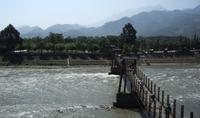 都江堰, on the west edge of the city, is an irrigation system built 2200 years ago (before gunpowder was invented) and still in use. No dam was erected. The clever design of 李冰 is still studied by every hydraulic engineers-to-be in China.
都江堰, on the west edge of the city, is an irrigation system built 2200 years ago (before gunpowder was invented) and still in use. No dam was erected. The clever design of 李冰 is still studied by every hydraulic engineers-to-be in China.
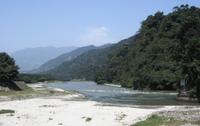 岷江 River is diverted here into two branches. Only one goes into the city for irrigation. By using different depth and width, this one never overflows nor dries out, while the outer river holds the majority of the volume when flooding, and bares its bottom when in drought. Another example, this picture shows 飞沙堰, a 200m buffer zone right at the water direction. On the side of it is the true water outlet at an angle. This effectively keeps the sediment of the inner river from flowing into the city.
岷江 River is diverted here into two branches. Only one goes into the city for irrigation. By using different depth and width, this one never overflows nor dries out, while the outer river holds the majority of the volume when flooding, and bares its bottom when in drought. Another example, this picture shows 飞沙堰, a 200m buffer zone right at the water direction. On the side of it is the true water outlet at an angle. This effectively keeps the sediment of the inner river from flowing into the city.
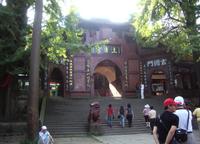 青城山 is only about 15 Km away. A pleasant place to visit in hot summer (much cooler here). Lots of buses (¥4.5) go from 都江堰 city's transit center to the entrance gate of the mountain. ¥60 (senior 50%). It's possible to take a chair lift (¥35, real SLOW) to get up halfway. In order to take it, you'll have to first take a large flat boat to cross a tiny lake (¥5, crossing time < 5 minutes, waiting time 5-15 mins until the boat is filled). Then it's only 1-2 Km's walk up to ShangQing Temple 上清宫 (built from the 300s. The current three characters were written by 蒋介石 Chiang Kai-shek). Here, one can continue up to 老君庙, or walk down. The walk is a lot more pleasant than the chair lift. Narrow. You can buy a cucumber from the peasants along the way or light a joss stick at 天师洞, where 张天师 (Taoism's founder) studied. It's in a large natural cave. In the old days, people came here to seek solitude or study Taoism. Now, you walk among vendors and flirting students (it was a Sunday), only the music that were softly playing in the speakers (hidden in the trees) still convey a little bit of the serenity.
青城山 is only about 15 Km away. A pleasant place to visit in hot summer (much cooler here). Lots of buses (¥4.5) go from 都江堰 city's transit center to the entrance gate of the mountain. ¥60 (senior 50%). It's possible to take a chair lift (¥35, real SLOW) to get up halfway. In order to take it, you'll have to first take a large flat boat to cross a tiny lake (¥5, crossing time < 5 minutes, waiting time 5-15 mins until the boat is filled). Then it's only 1-2 Km's walk up to ShangQing Temple 上清宫 (built from the 300s. The current three characters were written by 蒋介石 Chiang Kai-shek). Here, one can continue up to 老君庙, or walk down. The walk is a lot more pleasant than the chair lift. Narrow. You can buy a cucumber from the peasants along the way or light a joss stick at 天师洞, where 张天师 (Taoism's founder) studied. It's in a large natural cave. In the old days, people came here to seek solitude or study Taoism. Now, you walk among vendors and flirting students (it was a Sunday), only the music that were softly playing in the speakers (hidden in the trees) still convey a little bit of the serenity.
The city of 都江堰 is about an hour of bus ride (¥15.5, 56 Km) from 茶店子 transit center. Bus leaves as soon as it is filled, and it fills up quickly.
 都江堰, on the west edge of the city, is an irrigation system built 2200 years ago (before gunpowder was invented) and still in use. No dam was erected. The clever design of 李冰 is still studied by every hydraulic engineers-to-be in China.
都江堰, on the west edge of the city, is an irrigation system built 2200 years ago (before gunpowder was invented) and still in use. No dam was erected. The clever design of 李冰 is still studied by every hydraulic engineers-to-be in China. 岷江 River is diverted here into two branches. Only one goes into the city for irrigation. By using different depth and width, this one never overflows nor dries out, while the outer river holds the majority of the volume when flooding, and bares its bottom when in drought. Another example, this picture shows 飞沙堰, a 200m buffer zone right at the water direction. On the side of it is the true water outlet at an angle. This effectively keeps the sediment of the inner river from flowing into the city.
岷江 River is diverted here into two branches. Only one goes into the city for irrigation. By using different depth and width, this one never overflows nor dries out, while the outer river holds the majority of the volume when flooding, and bares its bottom when in drought. Another example, this picture shows 飞沙堰, a 200m buffer zone right at the water direction. On the side of it is the true water outlet at an angle. This effectively keeps the sediment of the inner river from flowing into the city. 青城山 is only about 15 Km away. A pleasant place to visit in hot summer (much cooler here). Lots of buses (¥4.5) go from 都江堰 city's transit center to the entrance gate of the mountain. ¥60 (senior 50%). It's possible to take a chair lift (¥35, real SLOW) to get up halfway. In order to take it, you'll have to first take a large flat boat to cross a tiny lake (¥5, crossing time < 5 minutes, waiting time 5-15 mins until the boat is filled). Then it's only 1-2 Km's walk up to ShangQing Temple 上清宫 (built from the 300s. The current three characters were written by 蒋介石 Chiang Kai-shek). Here, one can continue up to 老君庙, or walk down. The walk is a lot more pleasant than the chair lift. Narrow. You can buy a cucumber from the peasants along the way or light a joss stick at 天师洞, where 张天师 (Taoism's founder) studied. It's in a large natural cave. In the old days, people came here to seek solitude or study Taoism. Now, you walk among vendors and flirting students (it was a Sunday), only the music that were softly playing in the speakers (hidden in the trees) still convey a little bit of the serenity.
青城山 is only about 15 Km away. A pleasant place to visit in hot summer (much cooler here). Lots of buses (¥4.5) go from 都江堰 city's transit center to the entrance gate of the mountain. ¥60 (senior 50%). It's possible to take a chair lift (¥35, real SLOW) to get up halfway. In order to take it, you'll have to first take a large flat boat to cross a tiny lake (¥5, crossing time < 5 minutes, waiting time 5-15 mins until the boat is filled). Then it's only 1-2 Km's walk up to ShangQing Temple 上清宫 (built from the 300s. The current three characters were written by 蒋介石 Chiang Kai-shek). Here, one can continue up to 老君庙, or walk down. The walk is a lot more pleasant than the chair lift. Narrow. You can buy a cucumber from the peasants along the way or light a joss stick at 天师洞, where 张天师 (Taoism's founder) studied. It's in a large natural cave. In the old days, people came here to seek solitude or study Taoism. Now, you walk among vendors and flirting students (it was a Sunday), only the music that were softly playing in the speakers (hidden in the trees) still convey a little bit of the serenity.
China part 3 of 6: Jiuzhai 九寨沟 and Huanglong 黄龙: Karst geology. (9/13-16)
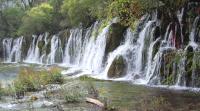
The small town Chuan-Zhu-Si 川主寺 has a new airport, about 45 min drive to 黄龙, and 90 min to 九寨沟. Every day, more than a dozen Boeing 757's fly in and then out. The flight to 成都 is only 40 minutes. However, on both directions, our flights were delayed by 3 hours. This is pretty common, not only because the bad planning of the airline dispatchers, mainly due to the weather. Altitude at 3446 m, amidst the mountain range, short runways, making the landing next to impossible in cloudy days. When we left at 11:30pm on 9/16, there were still hundreds of passengers stranded in the airport.
A cheaper alternative is bus (~¥150 instead of ¥770 each way), which follows 400 Km of mountain roads along the Min Jiang 岷江 River. 8-9 hours if everything goes smoothly. Landslide happens often, and you can be stuck for hours (as was my father last year).

We arrived at 九寨沟 at 5pm, even though we left our hotel in Chengdu just past 9am: a whole day affair to get here. Strolled to the park gate and back, bought a bottle of Tibetan barley wine 青稞扎酒, and some pancakes made of the same barley flour. We stayed at 九通 hotel (recommended by most online users) for 3 nights. Rooms are barely acceptable (¥160, I think we overpaid), but convenient: 1.5Km from the gate (one of the closest), and it shares a parking lot with the long distance bus company. It has a very nice indoor courtyard.
There're buses leaving for 黄龙 every morning at 7:10 and 8:00 (¥37). The bus has a layover of 4.5 hrs. It's possible to take the same bus back (¥40) or to get off at 川主寺 (¥20), so you can leave your bags on board.
 9/14, we arrived at Jiuzhai 九寨沟 ticket office at 6:30am. Combination ticket of ¥220 admission (students and senior ¥170) + ¥90 bus (no outside vehicles allowed in the park). We requested to come again the next day, and had our pictures printed on the tickets.
9/14, we arrived at Jiuzhai 九寨沟 ticket office at 6:30am. Combination ticket of ¥220 admission (students and senior ¥170) + ¥90 bus (no outside vehicles allowed in the park). We requested to come again the next day, and had our pictures printed on the tickets.
九寨沟 is THE place to see water. Super clear, blue-green. Quiet like a mirror or roaring as in the three major waterfalls.
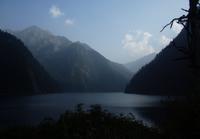 Park roads are in the form of a Y. One end is Long Lake 长海(the biggest in the park). Come here after 4pm, when everyone is gone. Otherwise, your toes may be stepped on -- yes, that many people. From here, walk down to 五彩池 5-color Pond. It's tiny, but gorgeous. The other end of the Y reaches undeveloped old growth forest. Very similar to the forest in Seattle area. Must have different species.
Park roads are in the form of a Y. One end is Long Lake 长海(the biggest in the park). Come here after 4pm, when everyone is gone. Otherwise, your toes may be stepped on -- yes, that many people. From here, walk down to 五彩池 5-color Pond. It's tiny, but gorgeous. The other end of the Y reaches undeveloped old growth forest. Very similar to the forest in Seattle area. Must have different species.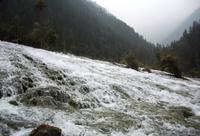 At the lower end of this branch is the beautiful pea-cock shaped 五花海 5-flower Lake (brightly colored); Pearl Shoal Falls 珍珠滩瀑布 (you can walk on the top of the falls where water jumps and glistens); and the peaceful Mirror Lake 镜海.
At the lower end of this branch is the beautiful pea-cock shaped 五花海 5-flower Lake (brightly colored); Pearl Shoal Falls 珍珠滩瀑布 (you can walk on the top of the falls where water jumps and glistens); and the peaceful Mirror Lake 镜海.
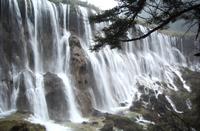 The two branches of Y connect at 诺日朗 tourist center, where you can transfer to the bus for another destination. Nothing to see in the center. Even though you can see 诺日朗瀑布 Ruorilong Falls from the bus, it's much better when you come closer.
The two branches of Y connect at 诺日朗 tourist center, where you can transfer to the bus for another destination. Nothing to see in the center. Even though you can see 诺日朗瀑布 Ruorilong Falls from the bus, it's much better when you come closer.
 At the trunk of the Y, the road follows the water course: many cascades, lakes. My favorite is Reed Lake 芦苇海: in between the stops, hardly anyone walk by. There's a blue strip winding in the reeds.
At the trunk of the Y, the road follows the water course: many cascades, lakes. My favorite is Reed Lake 芦苇海: in between the stops, hardly anyone walk by. There's a blue strip winding in the reeds.
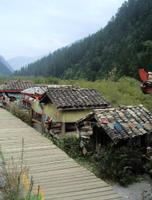 九寨沟 literally means "valley of nine villages", now three 藏 (a branch of the Tibetan) villages still exit in the park. These people are Buddhist. You can find many water mills used to turn the scripture cylinders. Colorful banners printed with words from the Buddhas, stringed together, fly high in air. It is said that every time a banner or a cylinder moves, a prayer is said.
九寨沟 literally means "valley of nine villages", now three 藏 (a branch of the Tibetan) villages still exit in the park. These people are Buddhist. You can find many water mills used to turn the scripture cylinders. Colorful banners printed with words from the Buddhas, stringed together, fly high in air. It is said that every time a banner or a cylinder moves, a prayer is said.
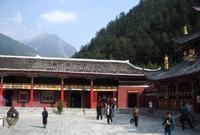 A formal temple is close to the park entrance: 扎如寺. Quite busy. They gave quick introduction and say prayers for the tourists in exchange for money. The large flat surface of the cliff in front of this temple is claimed to have segments resemble 12 zodiac animals -- all quite bogus.
A formal temple is close to the park entrance: 扎如寺. Quite busy. They gave quick introduction and say prayers for the tourists in exchange for money. The large flat surface of the cliff in front of this temple is claimed to have segments resemble 12 zodiac animals -- all quite bogus.
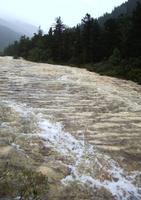 9/16, HuangLong 黄龙. We took the first bus and arrived around 10:30 am, about 0.5-1 hour ahead tour buses. It was foggy all the way, and before we arrived, it started raining.
9/16, HuangLong 黄龙. We took the first bus and arrived around 10:30 am, about 0.5-1 hour ahead tour buses. It was foggy all the way, and before we arrived, it started raining.
黄龙 (¥200, students and seniors ¥150) is world's largest continuous open-air travertine formation. Grand, impressive, and colorful. Miles long golden calcium bicarbonate slope, amidst green mountain range. If it's clear, it's possible to see the snowy peak of Xuebaoding 雪宝顶 (5588m).
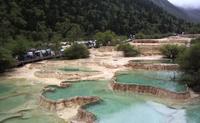 Algae and other aquatic plants' photosynthesis promotes the color and formation of the travertine ponds. These natural terraces of color are fascinating. Relentless rain and high altitude (from 3100m at the entrance to 3600m at the temple) cannot deter tourists' enthusiasm.
Algae and other aquatic plants' photosynthesis promotes the color and formation of the travertine ponds. These natural terraces of color are fascinating. Relentless rain and high altitude (from 3100m at the entrance to 3600m at the temple) cannot deter tourists' enthusiasm.
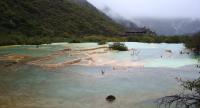 After 2.5 hr's walk on the gentle slope (~4Km), many photo shots and two stopovers for oxygen for my father (free, ¥1 breathing tube. I tried once, didn't feel any difference.), we reached the Taoist temple. The largest group of travertine ponds. Magnificent in all direction.
After 2.5 hr's walk on the gentle slope (~4Km), many photo shots and two stopovers for oxygen for my father (free, ¥1 breathing tube. I tried once, didn't feel any difference.), we reached the Taoist temple. The largest group of travertine ponds. Magnificent in all direction.
By the time we exited, the sun came out! On the gravel road back, while it zigzagged towards the mountain pass of over 4000m, we drank the mountain scenery that we missed on the way in: interesting rock formations, high snowy peaks briefly including 雪宝顶, some leftover snow on the grass.
 We arrived at 川主寺 around 5pm. Bought some yak meat, had supper (some interesting dishes: local wild mushrooms, and walnut flower?).
We arrived at 川主寺 around 5pm. Bought some yak meat, had supper (some interesting dishes: local wild mushrooms, and walnut flower?).
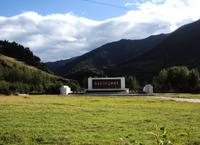 A memorial of Red Army's Long March 红军长征 was erected here in 1990. Between May and August 1936, the Red Army marched across the neighboring mountains and ravines, escaped the pursuit of the Nationalist. Even though a significant part of the troop was lost, the Communist managed to survive and kept its army, eventually (after over 10 years) kicked the Nationalist out of the mainland. Mao was also elected the head during the march.
A memorial of Red Army's Long March 红军长征 was erected here in 1990. Between May and August 1936, the Red Army marched across the neighboring mountains and ravines, escaped the pursuit of the Nationalist. Even though a significant part of the troop was lost, the Communist managed to survive and kept its army, eventually (after over 10 years) kicked the Nationalist out of the mainland. Mao was also elected the head during the march.

The small town Chuan-Zhu-Si 川主寺 has a new airport, about 45 min drive to 黄龙, and 90 min to 九寨沟. Every day, more than a dozen Boeing 757's fly in and then out. The flight to 成都 is only 40 minutes. However, on both directions, our flights were delayed by 3 hours. This is pretty common, not only because the bad planning of the airline dispatchers, mainly due to the weather. Altitude at 3446 m, amidst the mountain range, short runways, making the landing next to impossible in cloudy days. When we left at 11:30pm on 9/16, there were still hundreds of passengers stranded in the airport.
A cheaper alternative is bus (~¥150 instead of ¥770 each way), which follows 400 Km of mountain roads along the Min Jiang 岷江 River. 8-9 hours if everything goes smoothly. Landslide happens often, and you can be stuck for hours (as was my father last year).

We arrived at 九寨沟 at 5pm, even though we left our hotel in Chengdu just past 9am: a whole day affair to get here. Strolled to the park gate and back, bought a bottle of Tibetan barley wine 青稞扎酒, and some pancakes made of the same barley flour. We stayed at 九通 hotel (recommended by most online users) for 3 nights. Rooms are barely acceptable (¥160, I think we overpaid), but convenient: 1.5Km from the gate (one of the closest), and it shares a parking lot with the long distance bus company. It has a very nice indoor courtyard.
There're buses leaving for 黄龙 every morning at 7:10 and 8:00 (¥37). The bus has a layover of 4.5 hrs. It's possible to take the same bus back (¥40) or to get off at 川主寺 (¥20), so you can leave your bags on board.
 9/14, we arrived at Jiuzhai 九寨沟 ticket office at 6:30am. Combination ticket of ¥220 admission (students and senior ¥170) + ¥90 bus (no outside vehicles allowed in the park). We requested to come again the next day, and had our pictures printed on the tickets.
9/14, we arrived at Jiuzhai 九寨沟 ticket office at 6:30am. Combination ticket of ¥220 admission (students and senior ¥170) + ¥90 bus (no outside vehicles allowed in the park). We requested to come again the next day, and had our pictures printed on the tickets.九寨沟 is THE place to see water. Super clear, blue-green. Quiet like a mirror or roaring as in the three major waterfalls.
 Park roads are in the form of a Y. One end is Long Lake 长海(the biggest in the park). Come here after 4pm, when everyone is gone. Otherwise, your toes may be stepped on -- yes, that many people. From here, walk down to 五彩池 5-color Pond. It's tiny, but gorgeous. The other end of the Y reaches undeveloped old growth forest. Very similar to the forest in Seattle area. Must have different species.
Park roads are in the form of a Y. One end is Long Lake 长海(the biggest in the park). Come here after 4pm, when everyone is gone. Otherwise, your toes may be stepped on -- yes, that many people. From here, walk down to 五彩池 5-color Pond. It's tiny, but gorgeous. The other end of the Y reaches undeveloped old growth forest. Very similar to the forest in Seattle area. Must have different species. At the lower end of this branch is the beautiful pea-cock shaped 五花海 5-flower Lake (brightly colored); Pearl Shoal Falls 珍珠滩瀑布 (you can walk on the top of the falls where water jumps and glistens); and the peaceful Mirror Lake 镜海.
At the lower end of this branch is the beautiful pea-cock shaped 五花海 5-flower Lake (brightly colored); Pearl Shoal Falls 珍珠滩瀑布 (you can walk on the top of the falls where water jumps and glistens); and the peaceful Mirror Lake 镜海. The two branches of Y connect at 诺日朗 tourist center, where you can transfer to the bus for another destination. Nothing to see in the center. Even though you can see 诺日朗瀑布 Ruorilong Falls from the bus, it's much better when you come closer.
The two branches of Y connect at 诺日朗 tourist center, where you can transfer to the bus for another destination. Nothing to see in the center. Even though you can see 诺日朗瀑布 Ruorilong Falls from the bus, it's much better when you come closer. At the trunk of the Y, the road follows the water course: many cascades, lakes. My favorite is Reed Lake 芦苇海: in between the stops, hardly anyone walk by. There's a blue strip winding in the reeds.
At the trunk of the Y, the road follows the water course: many cascades, lakes. My favorite is Reed Lake 芦苇海: in between the stops, hardly anyone walk by. There's a blue strip winding in the reeds. 九寨沟 literally means "valley of nine villages", now three 藏 (a branch of the Tibetan) villages still exit in the park. These people are Buddhist. You can find many water mills used to turn the scripture cylinders. Colorful banners printed with words from the Buddhas, stringed together, fly high in air. It is said that every time a banner or a cylinder moves, a prayer is said.
九寨沟 literally means "valley of nine villages", now three 藏 (a branch of the Tibetan) villages still exit in the park. These people are Buddhist. You can find many water mills used to turn the scripture cylinders. Colorful banners printed with words from the Buddhas, stringed together, fly high in air. It is said that every time a banner or a cylinder moves, a prayer is said. A formal temple is close to the park entrance: 扎如寺. Quite busy. They gave quick introduction and say prayers for the tourists in exchange for money. The large flat surface of the cliff in front of this temple is claimed to have segments resemble 12 zodiac animals -- all quite bogus.
A formal temple is close to the park entrance: 扎如寺. Quite busy. They gave quick introduction and say prayers for the tourists in exchange for money. The large flat surface of the cliff in front of this temple is claimed to have segments resemble 12 zodiac animals -- all quite bogus.  9/16, HuangLong 黄龙. We took the first bus and arrived around 10:30 am, about 0.5-1 hour ahead tour buses. It was foggy all the way, and before we arrived, it started raining.
9/16, HuangLong 黄龙. We took the first bus and arrived around 10:30 am, about 0.5-1 hour ahead tour buses. It was foggy all the way, and before we arrived, it started raining.黄龙 (¥200, students and seniors ¥150) is world's largest continuous open-air travertine formation. Grand, impressive, and colorful. Miles long golden calcium bicarbonate slope, amidst green mountain range. If it's clear, it's possible to see the snowy peak of Xuebaoding 雪宝顶 (5588m).
 Algae and other aquatic plants' photosynthesis promotes the color and formation of the travertine ponds. These natural terraces of color are fascinating. Relentless rain and high altitude (from 3100m at the entrance to 3600m at the temple) cannot deter tourists' enthusiasm.
Algae and other aquatic plants' photosynthesis promotes the color and formation of the travertine ponds. These natural terraces of color are fascinating. Relentless rain and high altitude (from 3100m at the entrance to 3600m at the temple) cannot deter tourists' enthusiasm. After 2.5 hr's walk on the gentle slope (~4Km), many photo shots and two stopovers for oxygen for my father (free, ¥1 breathing tube. I tried once, didn't feel any difference.), we reached the Taoist temple. The largest group of travertine ponds. Magnificent in all direction.
After 2.5 hr's walk on the gentle slope (~4Km), many photo shots and two stopovers for oxygen for my father (free, ¥1 breathing tube. I tried once, didn't feel any difference.), we reached the Taoist temple. The largest group of travertine ponds. Magnificent in all direction.By the time we exited, the sun came out! On the gravel road back, while it zigzagged towards the mountain pass of over 4000m, we drank the mountain scenery that we missed on the way in: interesting rock formations, high snowy peaks briefly including 雪宝顶, some leftover snow on the grass.
 We arrived at 川主寺 around 5pm. Bought some yak meat, had supper (some interesting dishes: local wild mushrooms, and walnut flower?).
We arrived at 川主寺 around 5pm. Bought some yak meat, had supper (some interesting dishes: local wild mushrooms, and walnut flower?). A memorial of Red Army's Long March 红军长征 was erected here in 1990. Between May and August 1936, the Red Army marched across the neighboring mountains and ravines, escaped the pursuit of the Nationalist. Even though a significant part of the troop was lost, the Communist managed to survive and kept its army, eventually (after over 10 years) kicked the Nationalist out of the mainland. Mao was also elected the head during the march.
A memorial of Red Army's Long March 红军长征 was erected here in 1990. Between May and August 1936, the Red Army marched across the neighboring mountains and ravines, escaped the pursuit of the Nationalist. Even though a significant part of the troop was lost, the Communist managed to survive and kept its army, eventually (after over 10 years) kicked the Nationalist out of the mainland. Mao was also elected the head during the march.
China part 2 of 6: Chengdu 成都 (9/12 & 23)
Chengdu 成都 is the capital and roughly the geographic center of Sichuan 四川 province. It's easy to travel to other destinations from here. The 双流airport is less than 30Km south of city center (¥10 shuttle bus between the airport and 锦江宾馆). There're 4 major long distance bus centers on all 4 directions of the city.
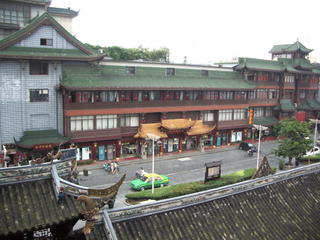 My favorite stree is Qintai Rd 琴台路: remodeled in the style of Han 汉 and Tang 唐 dynasties. It is where 卓文君 sold drinks after she eloped with 司马相如. (Click here for more about this 2000 year-old love story.) Two blocks of wide street, between 12-Bridge Rd (十二桥路) and South River (南河, or 浣花溪), stone pavement, inlaid with over 900 naturaly blue stones artistically carved with scenes of Han 汉 dynasty. Bronze statues, store fronts and even the street lamps are specially designed. Activities every night: tea ceremony, dances in costum, in order to lure the passers by. Busy, but not too noise.
My favorite stree is Qintai Rd 琴台路: remodeled in the style of Han 汉 and Tang 唐 dynasties. It is where 卓文君 sold drinks after she eloped with 司马相如. (Click here for more about this 2000 year-old love story.) Two blocks of wide street, between 12-Bridge Rd (十二桥路) and South River (南河, or 浣花溪), stone pavement, inlaid with over 900 naturaly blue stones artistically carved with scenes of Han 汉 dynasty. Bronze statues, store fronts and even the street lamps are specially designed. Activities every night: tea ceremony, dances in costum, in order to lure the passers by. Busy, but not too noise.
 We stayed at 文君楼 on Qintai Rd 琴台路. Very close to major attractions. In fact, we walked to 杜甫草堂. A very nice hotel, except that the water's temperature has its own mind. The best eatery in this neighborhood is the Long Wonton branch store at the 12-Bridge Rd (龙抄手十二桥路分店) next to the Chinese Medicine College (中医学院).
We stayed at 文君楼 on Qintai Rd 琴台路. Very close to major attractions. In fact, we walked to 杜甫草堂. A very nice hotel, except that the water's temperature has its own mind. The best eatery in this neighborhood is the Long Wonton branch store at the 12-Bridge Rd (龙抄手十二桥路分店) next to the Chinese Medicine College (中医学院).
 A block to the west is Qinyang Temple 青羊宫 (¥10), started in Tang 唐 dynasty. Legend has it that Taoism' creator 老子 left 尹喜 the Tao bible 道德经 on his way to the west, and told him to wait for him 1000 days later in Chengdu where a green sheep resides. This is said to be the location.
A block to the west is Qinyang Temple 青羊宫 (¥10), started in Tang 唐 dynasty. Legend has it that Taoism' creator 老子 left 尹喜 the Tao bible 道德经 on his way to the west, and told him to wait for him 1000 days later in Chengdu where a green sheep resides. This is said to be the location.
South of 琴台路, across the river 浣花溪 is a free public park: 百花潭公园, filled with people around dinner time, drinking tea, cracking watermelon seeds and playing Marjang. There's a year-round bonsai display emphasizes the local 巴蜀 style. A jinko tree of the 唐 dynasty. There's a stone sculpture next to the bridge entrance to the park commemorates the patriotic poet Lu,You (陆游 1125--1210), with a poem of his depicting the bloom of local plum blossoms:
当年走马锦城西,曾为梅花醉似泥,二十里中香不断,青羊宫到浣花溪.
It is the wrong season now for the plum blossoms. However, I got a whiff of the sweet scent of 桂花 (Osmanthus Fragrans Lour). They have a lot of this tree, but not in bloom yet.
 West of the park, bordering the river 浣花溪 is Dufu Thatched Hut 杜甫草堂 ¥60 (students and seniors 50%, seniors over 70 free), a park built on the location of the original hut where the great poet 杜甫 (712-770AD) stayed for almost 4 years after he escaped the political turmoil (安史之乱) in late 759 from the capital. He wrote over 200 poems here, among which is 茅屋为秋风所破歌 (always included in the middle school textbook).
West of the park, bordering the river 浣花溪 is Dufu Thatched Hut 杜甫草堂 ¥60 (students and seniors 50%, seniors over 70 free), a park built on the location of the original hut where the great poet 杜甫 (712-770AD) stayed for almost 4 years after he escaped the political turmoil (安史之乱) in late 759 from the capital. He wrote over 200 poems here, among which is 茅屋为秋风所破歌 (always included in the middle school textbook).
 The current park has been "renovated" throughout the history and expanded to include the neighboring 梵安寺 temple to the east and plum garden 梅园 to the west. Various pavilions / sculptures were added. You can find historial editions of books on 杜甫 and his writing. Nicely laid out gardens and ponds, pleasant to stoll about (before the tourist groups arrive). In the morning, you can see local seniors do group excersize here. Fun to watch.
The current park has been "renovated" throughout the history and expanded to include the neighboring 梵安寺 temple to the east and plum garden 梅园 to the west. Various pavilions / sculptures were added. You can find historial editions of books on 杜甫 and his writing. Nicely laid out gardens and ponds, pleasant to stoll about (before the tourist groups arrive). In the morning, you can see local seniors do group excersize here. Fun to watch.
 One court yard was delicated to bonsai and another to wooden plaques with 杜甫's poems written by famous people.
One court yard was delicated to bonsai and another to wooden plaques with 杜甫's poems written by famous people.
At the far end of this park, a new exhibition hall was openned at the begining of 2005, in order to protect and display the Tang 唐 ruin excavated here in 2001. You get a glimpse of what the local residence really looked like: quite primitive.
There's a free bus that runs between 杜甫草堂 and 武侯祠 if you buy the tickets from them. It runs on the hour between 10am-3pm.
 Wuhou Memorial 武侯祠 ¥60 (students and seniors 50%, seniors over 70 free) was originally built in the 7th centurys to honor the greatest strategist 诸葛亮 (181-234AD). Burnt during the wars, what we see now was built in the 1400s, and restored and expanded since then. The stone carvings of calligraphy surrounding the front courtyard are most interesting. Be sure to seek out 出师表 calligraphed by 陆游 near the entrance, and the Tang 唐 dynasty epitaph "蜀汉丞相诸葛武侯祠堂碑" (composed by 裴度,calligraphed by 柳公绰,and carved by 鲁建).
Wuhou Memorial 武侯祠 ¥60 (students and seniors 50%, seniors over 70 free) was originally built in the 7th centurys to honor the greatest strategist 诸葛亮 (181-234AD). Burnt during the wars, what we see now was built in the 1400s, and restored and expanded since then. The stone carvings of calligraphy surrounding the front courtyard are most interesting. Be sure to seek out 出师表 calligraphed by 陆游 near the entrance, and the Tang 唐 dynasty epitaph "蜀汉丞相诸葛武侯祠堂碑" (composed by 裴度,calligraphed by 柳公绰,and carved by 鲁建).
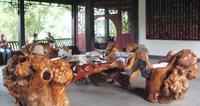 A couple of memorial halls form a straight line, starting from the one for the king 刘备, ending with 诸葛殿, housing silly yet colorful sculptures of the appropriate personage. To the west (have to go in next to the main south entrance) is 惠陵, the tomb of 刘备. The garden here is not as interesting, but, I found some very lovely chairs.
A couple of memorial halls form a straight line, starting from the one for the king 刘备, ending with 诸葛殿, housing silly yet colorful sculptures of the appropriate personage. To the west (have to go in next to the main south entrance) is 惠陵, the tomb of 刘备. The garden here is not as interesting, but, I found some very lovely chairs.
 The street next to 武侯祠 on the east, Jing-Li 锦里, is renovated in Ming 明 Qing 清 style. Filled with small vendors and eateries. Much smaller in scale, compared to 琴台路. Apart from these two traditional-style streets, Chun-Xi Rd 春熙路, a wide pedestrian street, is also worth some of your time. It's at the city center, the busiest shopping district. Do stop by 龙抄手, a traditional cafeteria famous for its snacks.
The street next to 武侯祠 on the east, Jing-Li 锦里, is renovated in Ming 明 Qing 清 style. Filled with small vendors and eateries. Much smaller in scale, compared to 琴台路. Apart from these two traditional-style streets, Chun-Xi Rd 春熙路, a wide pedestrian street, is also worth some of your time. It's at the city center, the busiest shopping district. Do stop by 龙抄手, a traditional cafeteria famous for its snacks.
 YongLin 永陵, a small museum containing just the tomb of king 王建 (847─918年). His family only ruled for two generations. Discovered in 1942, it has stone carvings of court band (the only one of the kind of that era), with 24 musicians playing various instruments. The tomb is at least 10 degrees cooler than outside. The best part is that we were the only visitors at that time.
YongLin 永陵, a small museum containing just the tomb of king 王建 (847─918年). His family only ruled for two generations. Discovered in 1942, it has stone carvings of court band (the only one of the kind of that era), with 24 musicians playing various instruments. The tomb is at least 10 degrees cooler than outside. The best part is that we were the only visitors at that time.
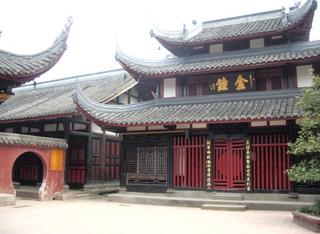 Wenshu Temple 文殊院 ¥20 (students 50%) is the headquarter of the provincial Buddhist Association, honoring Manjusri Bodhisattva. Started in Tang 唐 dynasty, destroyed in wars, restored by 慈笃 in 1681. Very busy here, full of chanting and incense. Not very interesting to nonbelievers like me, unless you want to try their vegetarian restaurant. I only took one picture of a building with my name on it.
Wenshu Temple 文殊院 ¥20 (students 50%) is the headquarter of the provincial Buddhist Association, honoring Manjusri Bodhisattva. Started in Tang 唐 dynasty, destroyed in wars, restored by 慈笃 in 1681. Very busy here, full of chanting and incense. Not very interesting to nonbelievers like me, unless you want to try their vegetarian restaurant. I only took one picture of a building with my name on it.
 To catch a long distance bus to the south, go to the main transit station (客运中心), where we went to an old town called HuangLongXi 黄龙溪镇 on our last day in SiChuan 四川. It is far less interesting than those water towns near Shanghai. The bus (¥11) is awfully slow: the driver stopped at every possible street before he filled the bus up. So 40-some Km took him 2 hours. On the way back, we took a bus to 双流 and asked to be dropped near the airport and then hailed a taxi.
To catch a long distance bus to the south, go to the main transit station (客运中心), where we went to an old town called HuangLongXi 黄龙溪镇 on our last day in SiChuan 四川. It is far less interesting than those water towns near Shanghai. The bus (¥11) is awfully slow: the driver stopped at every possible street before he filled the bus up. So 40-some Km took him 2 hours. On the way back, we took a bus to 双流 and asked to be dropped near the airport and then hailed a taxi.
卓文君, a young widow of both beauty and brain in the time of 汉武帝 (~100BC), also a connaisseur of music, is from a family of status. After hearing 凤求凰, a song composed and played for her by a young admirer 司马相如, eloped with this talented commoner. Her father disinherited her. In order to make a living, they ran a small bar, 文君 sold drinks and 相如 worked in the kitchen and sometimes played music. Eventually, her father calmed down and accepted them. Later, 相如 was summoned to the capital by the emperor. After 5 years, falling for another woman, 相如 sent his wife a n empty letter with just numbers, all except the number 亿, which shares the same sound as feeling 意. 文君 wrote back the following poem using all these numbers, and her husband was so ashamed and came home to take her with to the capital.
一别之后,两地相思,说的是三四月,却谁知是五六年。七弦琴无心弹,八行书无可传,九连环从中折断。十里长亭望眼欲穿。百般怨,千般念,万般无奈把郎怨。
万语千言道不尽,百无聊赖十凭栏。重九登高看孤雁,八月中秋月圆人不圆。七月半烧香秉烛问苍天,六月伏天人人摇扇我心寒,五月榴花如火偏遇阵阵冷雨浇花端,四月枇杷黄,我欲对镜心意乱,三月桃花随流水,二月风筝线儿断。噫!郎呀郎,巴不得下一世你为女来我为男。
凤求凰
凤兮凤兮归故乡,遨游四海求其凰。有一艳女在此堂,室迩人遐毒我肠,何由交接为鸳鸯?
凤兮凤兮从凰楼,得托子尾永为妃。交情通体必和谐,中夜相从别有谁?”
Chengdu 成都 is the capital and roughly the geographic center of Sichuan 四川 province. It's easy to travel to other destinations from here. The 双流airport is less than 30Km south of city center (¥10 shuttle bus between the airport and 锦江宾馆). There're 4 major long distance bus centers on all 4 directions of the city.
 My favorite stree is Qintai Rd 琴台路: remodeled in the style of Han 汉 and Tang 唐 dynasties. It is where 卓文君 sold drinks after she eloped with 司马相如. (Click here for more about this 2000 year-old love story.) Two blocks of wide street, between 12-Bridge Rd (十二桥路) and South River (南河, or 浣花溪), stone pavement, inlaid with over 900 naturaly blue stones artistically carved with scenes of Han 汉 dynasty. Bronze statues, store fronts and even the street lamps are specially designed. Activities every night: tea ceremony, dances in costum, in order to lure the passers by. Busy, but not too noise.
My favorite stree is Qintai Rd 琴台路: remodeled in the style of Han 汉 and Tang 唐 dynasties. It is where 卓文君 sold drinks after she eloped with 司马相如. (Click here for more about this 2000 year-old love story.) Two blocks of wide street, between 12-Bridge Rd (十二桥路) and South River (南河, or 浣花溪), stone pavement, inlaid with over 900 naturaly blue stones artistically carved with scenes of Han 汉 dynasty. Bronze statues, store fronts and even the street lamps are specially designed. Activities every night: tea ceremony, dances in costum, in order to lure the passers by. Busy, but not too noise. We stayed at 文君楼 on Qintai Rd 琴台路. Very close to major attractions. In fact, we walked to 杜甫草堂. A very nice hotel, except that the water's temperature has its own mind. The best eatery in this neighborhood is the Long Wonton branch store at the 12-Bridge Rd (龙抄手十二桥路分店) next to the Chinese Medicine College (中医学院).
We stayed at 文君楼 on Qintai Rd 琴台路. Very close to major attractions. In fact, we walked to 杜甫草堂. A very nice hotel, except that the water's temperature has its own mind. The best eatery in this neighborhood is the Long Wonton branch store at the 12-Bridge Rd (龙抄手十二桥路分店) next to the Chinese Medicine College (中医学院). A block to the west is Qinyang Temple 青羊宫 (¥10), started in Tang 唐 dynasty. Legend has it that Taoism' creator 老子 left 尹喜 the Tao bible 道德经 on his way to the west, and told him to wait for him 1000 days later in Chengdu where a green sheep resides. This is said to be the location.
A block to the west is Qinyang Temple 青羊宫 (¥10), started in Tang 唐 dynasty. Legend has it that Taoism' creator 老子 left 尹喜 the Tao bible 道德经 on his way to the west, and told him to wait for him 1000 days later in Chengdu where a green sheep resides. This is said to be the location.South of 琴台路, across the river 浣花溪 is a free public park: 百花潭公园, filled with people around dinner time, drinking tea, cracking watermelon seeds and playing Marjang. There's a year-round bonsai display emphasizes the local 巴蜀 style. A jinko tree of the 唐 dynasty. There's a stone sculpture next to the bridge entrance to the park commemorates the patriotic poet Lu,You (陆游 1125--1210), with a poem of his depicting the bloom of local plum blossoms:
当年走马锦城西,曾为梅花醉似泥,二十里中香不断,青羊宫到浣花溪.
It is the wrong season now for the plum blossoms. However, I got a whiff of the sweet scent of 桂花 (Osmanthus Fragrans Lour). They have a lot of this tree, but not in bloom yet.
 West of the park, bordering the river 浣花溪 is Dufu Thatched Hut 杜甫草堂 ¥60 (students and seniors 50%, seniors over 70 free), a park built on the location of the original hut where the great poet 杜甫 (712-770AD) stayed for almost 4 years after he escaped the political turmoil (安史之乱) in late 759 from the capital. He wrote over 200 poems here, among which is 茅屋为秋风所破歌 (always included in the middle school textbook).
West of the park, bordering the river 浣花溪 is Dufu Thatched Hut 杜甫草堂 ¥60 (students and seniors 50%, seniors over 70 free), a park built on the location of the original hut where the great poet 杜甫 (712-770AD) stayed for almost 4 years after he escaped the political turmoil (安史之乱) in late 759 from the capital. He wrote over 200 poems here, among which is 茅屋为秋风所破歌 (always included in the middle school textbook). The current park has been "renovated" throughout the history and expanded to include the neighboring 梵安寺 temple to the east and plum garden 梅园 to the west. Various pavilions / sculptures were added. You can find historial editions of books on 杜甫 and his writing. Nicely laid out gardens and ponds, pleasant to stoll about (before the tourist groups arrive). In the morning, you can see local seniors do group excersize here. Fun to watch.
The current park has been "renovated" throughout the history and expanded to include the neighboring 梵安寺 temple to the east and plum garden 梅园 to the west. Various pavilions / sculptures were added. You can find historial editions of books on 杜甫 and his writing. Nicely laid out gardens and ponds, pleasant to stoll about (before the tourist groups arrive). In the morning, you can see local seniors do group excersize here. Fun to watch. One court yard was delicated to bonsai and another to wooden plaques with 杜甫's poems written by famous people.
One court yard was delicated to bonsai and another to wooden plaques with 杜甫's poems written by famous people.At the far end of this park, a new exhibition hall was openned at the begining of 2005, in order to protect and display the Tang 唐 ruin excavated here in 2001. You get a glimpse of what the local residence really looked like: quite primitive.
There's a free bus that runs between 杜甫草堂 and 武侯祠 if you buy the tickets from them. It runs on the hour between 10am-3pm.
 Wuhou Memorial 武侯祠 ¥60 (students and seniors 50%, seniors over 70 free) was originally built in the 7th centurys to honor the greatest strategist 诸葛亮 (181-234AD). Burnt during the wars, what we see now was built in the 1400s, and restored and expanded since then. The stone carvings of calligraphy surrounding the front courtyard are most interesting. Be sure to seek out 出师表 calligraphed by 陆游 near the entrance, and the Tang 唐 dynasty epitaph "蜀汉丞相诸葛武侯祠堂碑" (composed by 裴度,calligraphed by 柳公绰,and carved by 鲁建).
Wuhou Memorial 武侯祠 ¥60 (students and seniors 50%, seniors over 70 free) was originally built in the 7th centurys to honor the greatest strategist 诸葛亮 (181-234AD). Burnt during the wars, what we see now was built in the 1400s, and restored and expanded since then. The stone carvings of calligraphy surrounding the front courtyard are most interesting. Be sure to seek out 出师表 calligraphed by 陆游 near the entrance, and the Tang 唐 dynasty epitaph "蜀汉丞相诸葛武侯祠堂碑" (composed by 裴度,calligraphed by 柳公绰,and carved by 鲁建). A couple of memorial halls form a straight line, starting from the one for the king 刘备, ending with 诸葛殿, housing silly yet colorful sculptures of the appropriate personage. To the west (have to go in next to the main south entrance) is 惠陵, the tomb of 刘备. The garden here is not as interesting, but, I found some very lovely chairs.
A couple of memorial halls form a straight line, starting from the one for the king 刘备, ending with 诸葛殿, housing silly yet colorful sculptures of the appropriate personage. To the west (have to go in next to the main south entrance) is 惠陵, the tomb of 刘备. The garden here is not as interesting, but, I found some very lovely chairs. The street next to 武侯祠 on the east, Jing-Li 锦里, is renovated in Ming 明 Qing 清 style. Filled with small vendors and eateries. Much smaller in scale, compared to 琴台路. Apart from these two traditional-style streets, Chun-Xi Rd 春熙路, a wide pedestrian street, is also worth some of your time. It's at the city center, the busiest shopping district. Do stop by 龙抄手, a traditional cafeteria famous for its snacks.
The street next to 武侯祠 on the east, Jing-Li 锦里, is renovated in Ming 明 Qing 清 style. Filled with small vendors and eateries. Much smaller in scale, compared to 琴台路. Apart from these two traditional-style streets, Chun-Xi Rd 春熙路, a wide pedestrian street, is also worth some of your time. It's at the city center, the busiest shopping district. Do stop by 龙抄手, a traditional cafeteria famous for its snacks. YongLin 永陵, a small museum containing just the tomb of king 王建 (847─918年). His family only ruled for two generations. Discovered in 1942, it has stone carvings of court band (the only one of the kind of that era), with 24 musicians playing various instruments. The tomb is at least 10 degrees cooler than outside. The best part is that we were the only visitors at that time.
YongLin 永陵, a small museum containing just the tomb of king 王建 (847─918年). His family only ruled for two generations. Discovered in 1942, it has stone carvings of court band (the only one of the kind of that era), with 24 musicians playing various instruments. The tomb is at least 10 degrees cooler than outside. The best part is that we were the only visitors at that time. Wenshu Temple 文殊院 ¥20 (students 50%) is the headquarter of the provincial Buddhist Association, honoring Manjusri Bodhisattva. Started in Tang 唐 dynasty, destroyed in wars, restored by 慈笃 in 1681. Very busy here, full of chanting and incense. Not very interesting to nonbelievers like me, unless you want to try their vegetarian restaurant. I only took one picture of a building with my name on it.
Wenshu Temple 文殊院 ¥20 (students 50%) is the headquarter of the provincial Buddhist Association, honoring Manjusri Bodhisattva. Started in Tang 唐 dynasty, destroyed in wars, restored by 慈笃 in 1681. Very busy here, full of chanting and incense. Not very interesting to nonbelievers like me, unless you want to try their vegetarian restaurant. I only took one picture of a building with my name on it. To catch a long distance bus to the south, go to the main transit station (客运中心), where we went to an old town called HuangLongXi 黄龙溪镇 on our last day in SiChuan 四川. It is far less interesting than those water towns near Shanghai. The bus (¥11) is awfully slow: the driver stopped at every possible street before he filled the bus up. So 40-some Km took him 2 hours. On the way back, we took a bus to 双流 and asked to be dropped near the airport and then hailed a taxi.
To catch a long distance bus to the south, go to the main transit station (客运中心), where we went to an old town called HuangLongXi 黄龙溪镇 on our last day in SiChuan 四川. It is far less interesting than those water towns near Shanghai. The bus (¥11) is awfully slow: the driver stopped at every possible street before he filled the bus up. So 40-some Km took him 2 hours. On the way back, we took a bus to 双流 and asked to be dropped near the airport and then hailed a taxi.卓文君, a young widow of both beauty and brain in the time of 汉武帝 (~100BC), also a connaisseur of music, is from a family of status. After hearing 凤求凰, a song composed and played for her by a young admirer 司马相如, eloped with this talented commoner. Her father disinherited her. In order to make a living, they ran a small bar, 文君 sold drinks and 相如 worked in the kitchen and sometimes played music. Eventually, her father calmed down and accepted them. Later, 相如 was summoned to the capital by the emperor. After 5 years, falling for another woman, 相如 sent his wife a n empty letter with just numbers, all except the number 亿, which shares the same sound as feeling 意. 文君 wrote back the following poem using all these numbers, and her husband was so ashamed and came home to take her with to the capital.
一别之后,两地相思,说的是三四月,却谁知是五六年。七弦琴无心弹,八行书无可传,九连环从中折断。十里长亭望眼欲穿。百般怨,千般念,万般无奈把郎怨。
万语千言道不尽,百无聊赖十凭栏。重九登高看孤雁,八月中秋月圆人不圆。七月半烧香秉烛问苍天,六月伏天人人摇扇我心寒,五月榴花如火偏遇阵阵冷雨浇花端,四月枇杷黄,我欲对镜心意乱,三月桃花随流水,二月风筝线儿断。噫!郎呀郎,巴不得下一世你为女来我为男。
凤求凰
凤兮凤兮归故乡,遨游四海求其凰。有一艳女在此堂,室迩人遐毒我肠,何由交接为鸳鸯?
凤兮凤兮从凰楼,得托子尾永为妃。交情通体必和谐,中夜相从别有谁?”
China 2005/9/7-27
Part 1 of 6: Shanghai 上海
It's been over 6 years since I last visited my home town, Shanghai, a city of light. Over 16 million residents. The city's daily population is much more. 24-hour activities, non-stop from Majang table to prostitution (illegal in China). Congested streets and highways (the city government charges ~$4000 for each license plate, but still too many applications. Now a lottery system is in place to grant to a few thousand car owners every month). Fast urban sprawling (10x in each direction in the past 10 years). 3 skyscrapers are built every day (which also causes the city sinking). The highest, at 421 meters, is now a Hyatt.
Income disparity is alarming. A small glass of beer can be as little as 30 cents, or as high as $10, both have countless buyers. Restaurants looking like palaces (sometimes completed with spas) are full every night. Migrant workers making less than $1 an hour bike to work in order to save a bus ticket. Everyone is talking about money making. It's amazing that no major social unrest has erupt.
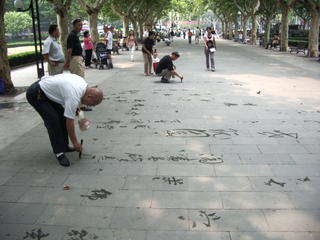 This is an ordinary small park (襄阳公园 free now), but it's among my favorite spots in Shanghai. Retired and laid-off locals hang out here to dance, do Tai Chi, and some practice calligraphy on the pavement using just a brush and a bucket of water. Its next door is the (ill)famed market for counterfeit products.
This is an ordinary small park (襄阳公园 free now), but it's among my favorite spots in Shanghai. Retired and laid-off locals hang out here to dance, do Tai Chi, and some practice calligraphy on the pavement using just a brush and a bucket of water. Its next door is the (ill)famed market for counterfeit products.
Xintiandi (新天地) is a redevelopment of a couple of blocks in the city center next to the first meeting site (中共一大会址) of Chinese Communist Party. Here is where you can buy a glass of beer for $10. My grandma's house used to be in similar style (石库门) a few blocks away, now gone. In fact the whole street where her house used to stand was completely rebuilt. It looks like a side street of the 5th avenue in New York, maybe more flashy.
Shanghai has one of the best museums in the world: Shanghai Museum, and arguably the best art gallery in the country: Shanghai Art Museum. Apart from museums and art galleries, a few local artists have rented a block of out-dated warehouses at 50 Moganshan Rd (莫干山路). A bit of redecoration converted them to galleries and gathering halls. They claim to make it a Chinese "Rive Gauche".
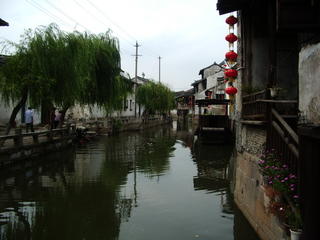 There are many well preserved little towns worth a few day trips from Shanghai (around 100Km away), reflecting the old-time country scenery (江南水乡). I only had time to visit one of them: Xi-Tang (西塘). (practicality) Many of these towns are not far from each other. It's possible to visit a few of these in a same trip. They are all over 1000 years old, with historical and culture significances. However, the surviving architecture is of dynasty Ming 明 or Qing 清. Stone bridges and waterways, narrow alleys (width of just 1m sometimes). Even the throngs of tourists couldn't damp the limpid air and slow pace.
There are many well preserved little towns worth a few day trips from Shanghai (around 100Km away), reflecting the old-time country scenery (江南水乡). I only had time to visit one of them: Xi-Tang (西塘). (practicality) Many of these towns are not far from each other. It's possible to visit a few of these in a same trip. They are all over 1000 years old, with historical and culture significances. However, the surviving architecture is of dynasty Ming 明 or Qing 清. Stone bridges and waterways, narrow alleys (width of just 1m sometimes). Even the throngs of tourists couldn't damp the limpid air and slow pace.
西塘 is famous for its long corridors with covered roofs (烟雨长廊) along the river, built separately by each family due to the long rainy days. This is also the hometown of Shanghai's former vice mayor Ni 倪天增.
There're a few central travel hubs in Shanghai 上海旅游集散中心 that organize short trips. Government controlled. There's a air-conditioned direct tour bus at 9:30am from the Shanghai Stadium (上海体育场12号门5号扶梯下), and coming back from 西塘 at 4pm everyday. Cost of transportation: ¥60 Yuan ($8). Another ¥60 for a combination ticket of 11 points, which to my opinion is not necessary. No one checked our tickets, except at the door steps of these 11 points. You can just walked into the old town and stroll around, visit a couple of private homes (¥5), have a country meal (农家菜) and head back. Out of these 11 places (private homes are not part of the combination tickets), only one really worths the visit: West Garden (西园). This is a house with a tiny Suzhou-style garden 苏州园林. Built across a public alley, two elevated walkways connect the two parts. Dec of 1920, members of 南社 literary club and 5 local poets gathered here, had a merry time. The next year poet Liu 柳亚子 lived here. It now houses a small gallery dedicated to 南社. You can find some handwriting of these poets. The gallery of root sculpture is not bad either.
I spent most of my vacation making a few trips in Si-Chuan province (四川9/11-23) using its capital Chengdu 成都 as a base (2.5 hours flight west of Shanghai).
You'll find many practical advices here. I bought our plane tickets from them, delivered in a day without extra charge. However, most online postings are in Chinese.
Part 1 of 6: Shanghai 上海
It's been over 6 years since I last visited my home town, Shanghai, a city of light. Over 16 million residents. The city's daily population is much more. 24-hour activities, non-stop from Majang table to prostitution (illegal in China). Congested streets and highways (the city government charges ~$4000 for each license plate, but still too many applications. Now a lottery system is in place to grant to a few thousand car owners every month). Fast urban sprawling (10x in each direction in the past 10 years). 3 skyscrapers are built every day (which also causes the city sinking). The highest, at 421 meters, is now a Hyatt.
Income disparity is alarming. A small glass of beer can be as little as 30 cents, or as high as $10, both have countless buyers. Restaurants looking like palaces (sometimes completed with spas) are full every night. Migrant workers making less than $1 an hour bike to work in order to save a bus ticket. Everyone is talking about money making. It's amazing that no major social unrest has erupt.
 This is an ordinary small park (襄阳公园 free now), but it's among my favorite spots in Shanghai. Retired and laid-off locals hang out here to dance, do Tai Chi, and some practice calligraphy on the pavement using just a brush and a bucket of water. Its next door is the (ill)famed market for counterfeit products.
This is an ordinary small park (襄阳公园 free now), but it's among my favorite spots in Shanghai. Retired and laid-off locals hang out here to dance, do Tai Chi, and some practice calligraphy on the pavement using just a brush and a bucket of water. Its next door is the (ill)famed market for counterfeit products.Xintiandi (新天地) is a redevelopment of a couple of blocks in the city center next to the first meeting site (中共一大会址) of Chinese Communist Party. Here is where you can buy a glass of beer for $10. My grandma's house used to be in similar style (石库门) a few blocks away, now gone. In fact the whole street where her house used to stand was completely rebuilt. It looks like a side street of the 5th avenue in New York, maybe more flashy.
Shanghai has one of the best museums in the world: Shanghai Museum, and arguably the best art gallery in the country: Shanghai Art Museum. Apart from museums and art galleries, a few local artists have rented a block of out-dated warehouses at 50 Moganshan Rd (莫干山路). A bit of redecoration converted them to galleries and gathering halls. They claim to make it a Chinese "Rive Gauche".
 There are many well preserved little towns worth a few day trips from Shanghai (around 100Km away), reflecting the old-time country scenery (江南水乡). I only had time to visit one of them: Xi-Tang (西塘). (practicality) Many of these towns are not far from each other. It's possible to visit a few of these in a same trip. They are all over 1000 years old, with historical and culture significances. However, the surviving architecture is of dynasty Ming 明 or Qing 清. Stone bridges and waterways, narrow alleys (width of just 1m sometimes). Even the throngs of tourists couldn't damp the limpid air and slow pace.
There are many well preserved little towns worth a few day trips from Shanghai (around 100Km away), reflecting the old-time country scenery (江南水乡). I only had time to visit one of them: Xi-Tang (西塘). (practicality) Many of these towns are not far from each other. It's possible to visit a few of these in a same trip. They are all over 1000 years old, with historical and culture significances. However, the surviving architecture is of dynasty Ming 明 or Qing 清. Stone bridges and waterways, narrow alleys (width of just 1m sometimes). Even the throngs of tourists couldn't damp the limpid air and slow pace.西塘 is famous for its long corridors with covered roofs (烟雨长廊) along the river, built separately by each family due to the long rainy days. This is also the hometown of Shanghai's former vice mayor Ni 倪天增.
There're a few central travel hubs in Shanghai 上海旅游集散中心 that organize short trips. Government controlled. There's a air-conditioned direct tour bus at 9:30am from the Shanghai Stadium (上海体育场12号门5号扶梯下), and coming back from 西塘 at 4pm everyday. Cost of transportation: ¥60 Yuan ($8). Another ¥60 for a combination ticket of 11 points, which to my opinion is not necessary. No one checked our tickets, except at the door steps of these 11 points. You can just walked into the old town and stroll around, visit a couple of private homes (¥5), have a country meal (农家菜) and head back. Out of these 11 places (private homes are not part of the combination tickets), only one really worths the visit: West Garden (西园). This is a house with a tiny Suzhou-style garden 苏州园林. Built across a public alley, two elevated walkways connect the two parts. Dec of 1920, members of 南社 literary club and 5 local poets gathered here, had a merry time. The next year poet Liu 柳亚子 lived here. It now houses a small gallery dedicated to 南社. You can find some handwriting of these poets. The gallery of root sculpture is not bad either.
I spent most of my vacation making a few trips in Si-Chuan province (四川9/11-23) using its capital Chengdu 成都 as a base (2.5 hours flight west of Shanghai).
You'll find many practical advices here. I bought our plane tickets from them, delivered in a day without extra charge. However, most online postings are in Chinese.
Monday, August 29, 2005
Gothic Basin
8/27/2005 Sat. Overcast in the morning.
~15 Km RT / 900 m gain to the basin.
 The first 1.7 miles is completely flat on Monte Criso Rd, along Sauk River. Then the grade picks up. After 2 miles or so, the trail leaves the zigzag in the forest and you encounter the first waterfalls (a trickle now). From here on, the trail becomes rocky and not as steep, but sometimes up and down. Gothic Basin is ideal for camping, surrounding by rocky peaks that can shelter the wind, a couple of tarns to supply water.
The first 1.7 miles is completely flat on Monte Criso Rd, along Sauk River. Then the grade picks up. After 2 miles or so, the trail leaves the zigzag in the forest and you encounter the first waterfalls (a trickle now). From here on, the trail becomes rocky and not as steep, but sometimes up and down. Gothic Basin is ideal for camping, surrounding by rocky peaks that can shelter the wind, a couple of tarns to supply water.
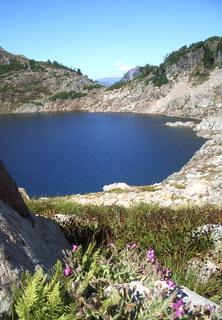 A further half mile / 200 ft up to the right (northeast) over a low ridge leads to the beautiful foggy lake. More camp sites.
A further half mile / 200 ft up to the right (northeast) over a low ridge leads to the beautiful foggy lake. More camp sites.
If you are not tired yet, it's possible to climb up the STEEP hill on the south side. On top of that ridge, you can see Rainier and Olympics. We came down directly to the basin. It was quite dangerous. So steep that most of the time I had all my limbs on the stones. My pants ended up with purple blueberry stain. Yes, lots of blueberries.

8/27/2005 Sat. Overcast in the morning.
~15 Km RT / 900 m gain to the basin.
 The first 1.7 miles is completely flat on Monte Criso Rd, along Sauk River. Then the grade picks up. After 2 miles or so, the trail leaves the zigzag in the forest and you encounter the first waterfalls (a trickle now). From here on, the trail becomes rocky and not as steep, but sometimes up and down. Gothic Basin is ideal for camping, surrounding by rocky peaks that can shelter the wind, a couple of tarns to supply water.
The first 1.7 miles is completely flat on Monte Criso Rd, along Sauk River. Then the grade picks up. After 2 miles or so, the trail leaves the zigzag in the forest and you encounter the first waterfalls (a trickle now). From here on, the trail becomes rocky and not as steep, but sometimes up and down. Gothic Basin is ideal for camping, surrounding by rocky peaks that can shelter the wind, a couple of tarns to supply water. A further half mile / 200 ft up to the right (northeast) over a low ridge leads to the beautiful foggy lake. More camp sites.
A further half mile / 200 ft up to the right (northeast) over a low ridge leads to the beautiful foggy lake. More camp sites.If you are not tired yet, it's possible to climb up the STEEP hill on the south side. On top of that ridge, you can see Rainier and Olympics. We came down directly to the basin. It was quite dangerous. So steep that most of the time I had all my limbs on the stones. My pants ended up with purple blueberry stain. Yes, lots of blueberries.

Thursday, August 25, 2005
Intimate Apparel at Intiman Theatre
2005.8.25 7:30pm
Opening night. Full house. It started at least 15 min late.
A new play, by Lynn Nottage, directed by Jacqueline Moscou (whose previous production the Crown last year was such a bore).
It's a story of an illiterate but independent African seamstress in early 20th century New York, earning her living sewing "intimate apparel" for wealthy socialites and women of ill repute. Esther, who's in her mid-30s longs for companionship. After some months of correspondence with a Panama canal digger, she marries him as soon as he arrives without getting to know him. She finds warmth with a man she cannot touch, a Romanian textile retailer.
It's well written (quite humorous at times) and well acted, especially the lady who plays the prostitute. Stage design is simple but sufficient.
The odd thing is that after the show, they served fried Chicken with Coleslaw, mashed potato and sweet rolls (donated by Ezel?).
2005.8.25 7:30pm
Opening night. Full house. It started at least 15 min late.
A new play, by Lynn Nottage, directed by Jacqueline Moscou (whose previous production the Crown last year was such a bore).
It's a story of an illiterate but independent African seamstress in early 20th century New York, earning her living sewing "intimate apparel" for wealthy socialites and women of ill repute. Esther, who's in her mid-30s longs for companionship. After some months of correspondence with a Panama canal digger, she marries him as soon as he arrives without getting to know him. She finds warmth with a man she cannot touch, a Romanian textile retailer.
It's well written (quite humorous at times) and well acted, especially the lady who plays the prostitute. Stage design is simple but sufficient.
The odd thing is that after the show, they served fried Chicken with Coleslaw, mashed potato and sweet rolls (donated by Ezel?).
Tuesday, August 23, 2005
2005.8.20-22 Vancouver Island
It started out drizzling. Only the last day was sunny. Didn't enjoy much of the mountains, as the views were blocked by the clouds. I have underestimated the size of the island, plus the foul weather, the whole trip was ill-planned (the hotels do not allow cancellation). Long wait for the ferry coming back on Monday night. My favorites of this trip are lower Myra Falls and Chesterman Beach.
 Day 1. We started with Strathcona Provincial Park. Visited the Buttle Lake area. The drive was very pleasant, although, long. It passes several lakes, some quite large. The upper Campbell Lake is very pleasant. Should have stayed here in the lodge (decent menu). Buttle Lake is utterly peaceful. Huge, and almost no one around.
Day 1. We started with Strathcona Provincial Park. Visited the Buttle Lake area. The drive was very pleasant, although, long. It passes several lakes, some quite large. The upper Campbell Lake is very pleasant. Should have stayed here in the lodge (decent menu). Buttle Lake is utterly peaceful. Huge, and almost no one around.
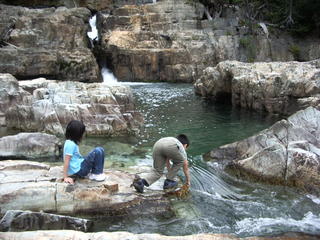 We did a couple of short hikes along Buttle Lake to see some waterfalls. Lower Myra Falls is a must. The kids (me too) enjoyed it immensely. Very interesting rock formation, and one can climb back and forth along the cascades.
We did a couple of short hikes along Buttle Lake to see some waterfalls. Lower Myra Falls is a must. The kids (me too) enjoyed it immensely. Very interesting rock formation, and one can climb back and forth along the cascades.
Day 2. We stayed in the Mt Washington Ski Resort. The kids loved their bunk beds, but they were not made, and there's no where I can find extra sheets (and the woman who is in charge of these rental vacation homes didn't want to make the trip to deliver the sheets). That was quite annoying. However, the view from the mountain top was nice, if it's not cloudy. Ski lift is in operation.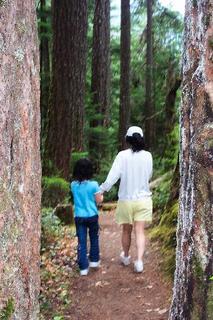 We spent half a day walking the Paradise Meadows and visited the two little alpine lakes near by: Ann-Mckinzie Lake and Battleship Lake. However, the lakes are quite boring. The meadow is very pleasant, well preserved, wide board walkways, still has some flowers left. I can imagine coming here maybe two weeks earlier and the flowers should have been splendid.
We spent half a day walking the Paradise Meadows and visited the two little alpine lakes near by: Ann-Mckinzie Lake and Battleship Lake. However, the lakes are quite boring. The meadow is very pleasant, well preserved, wide board walkways, still has some flowers left. I can imagine coming here maybe two weeks earlier and the flowers should have been splendid.
As the only restaurant that opens in the evening is quite lousy, we drove down to Courteney for dinner (the Old House @ 1760 Riverside Lane. Easy to miss.) A very old house indeed, beautiful garden along a creek. Food is quite good, the waitress was helpful. She didn't make a face after my nephew made a mess over the table (he threw up, as sometime he does after gorging in cold food). On the way there, we stopped by Saratoga Beach and Miracle Beach. Very close to each other (I prefer Miracle Beach, also a park). We saw a heron at Saratoga Beach. On the little residential street that connects these two beaches, we saw two deers!
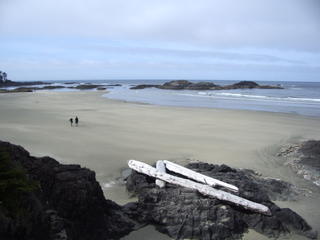 Day 3. Visited the beaches in the Pacific Rim National Park and Tofino.
First stop is Wickaninnish Beach. There's an interpretive center and a restaurant here. Sea stacks on and off the beach, yet, the sand is ultra fine and smooth. Quite some people here.
Day 3. Visited the beaches in the Pacific Rim National Park and Tofino.
First stop is Wickaninnish Beach. There's an interpretive center and a restaurant here. Sea stacks on and off the beach, yet, the sand is ultra fine and smooth. Quite some people here.
2nd stop, Long Beach. Same, but no facilities. Nice. Quite a few surfers here. The kids followed me to get wet, playing with the waves.
3rd stop, Radar hill. Good view to Tofino and countless little green islands in the sound.
4th stop, Tofino (at the north tip of this peninsular). Small yet bustling. Quite a few groups going in and out of the harbor. Very commercialized.
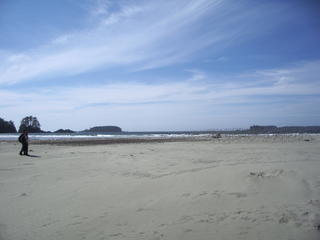 Last stop, on the way back, Chesterman Beach. Beautiful. Other than its fine sandy beach, views go both north (islands) and south (Long Beach), AND thousands of sandpipers.
Last stop, on the way back, Chesterman Beach. Beautiful. Other than its fine sandy beach, views go both north (islands) and south (Long Beach), AND thousands of sandpipers.
 Day 1. We started with Strathcona Provincial Park. Visited the Buttle Lake area. The drive was very pleasant, although, long. It passes several lakes, some quite large. The upper Campbell Lake is very pleasant. Should have stayed here in the lodge (decent menu). Buttle Lake is utterly peaceful. Huge, and almost no one around.
Day 1. We started with Strathcona Provincial Park. Visited the Buttle Lake area. The drive was very pleasant, although, long. It passes several lakes, some quite large. The upper Campbell Lake is very pleasant. Should have stayed here in the lodge (decent menu). Buttle Lake is utterly peaceful. Huge, and almost no one around.
 We did a couple of short hikes along Buttle Lake to see some waterfalls. Lower Myra Falls is a must. The kids (me too) enjoyed it immensely. Very interesting rock formation, and one can climb back and forth along the cascades.
We did a couple of short hikes along Buttle Lake to see some waterfalls. Lower Myra Falls is a must. The kids (me too) enjoyed it immensely. Very interesting rock formation, and one can climb back and forth along the cascades.
Day 2. We stayed in the Mt Washington Ski Resort. The kids loved their bunk beds, but they were not made, and there's no where I can find extra sheets (and the woman who is in charge of these rental vacation homes didn't want to make the trip to deliver the sheets). That was quite annoying. However, the view from the mountain top was nice, if it's not cloudy. Ski lift is in operation.
 We spent half a day walking the Paradise Meadows and visited the two little alpine lakes near by: Ann-Mckinzie Lake and Battleship Lake. However, the lakes are quite boring. The meadow is very pleasant, well preserved, wide board walkways, still has some flowers left. I can imagine coming here maybe two weeks earlier and the flowers should have been splendid.
We spent half a day walking the Paradise Meadows and visited the two little alpine lakes near by: Ann-Mckinzie Lake and Battleship Lake. However, the lakes are quite boring. The meadow is very pleasant, well preserved, wide board walkways, still has some flowers left. I can imagine coming here maybe two weeks earlier and the flowers should have been splendid.
As the only restaurant that opens in the evening is quite lousy, we drove down to Courteney for dinner (the Old House @ 1760 Riverside Lane. Easy to miss.) A very old house indeed, beautiful garden along a creek. Food is quite good, the waitress was helpful. She didn't make a face after my nephew made a mess over the table (he threw up, as sometime he does after gorging in cold food). On the way there, we stopped by Saratoga Beach and Miracle Beach. Very close to each other (I prefer Miracle Beach, also a park). We saw a heron at Saratoga Beach. On the little residential street that connects these two beaches, we saw two deers!
 Day 3. Visited the beaches in the Pacific Rim National Park and Tofino.
First stop is Wickaninnish Beach. There's an interpretive center and a restaurant here. Sea stacks on and off the beach, yet, the sand is ultra fine and smooth. Quite some people here.
Day 3. Visited the beaches in the Pacific Rim National Park and Tofino.
First stop is Wickaninnish Beach. There's an interpretive center and a restaurant here. Sea stacks on and off the beach, yet, the sand is ultra fine and smooth. Quite some people here.
2nd stop, Long Beach. Same, but no facilities. Nice. Quite a few surfers here. The kids followed me to get wet, playing with the waves.
3rd stop, Radar hill. Good view to Tofino and countless little green islands in the sound.
4th stop, Tofino (at the north tip of this peninsular). Small yet bustling. Quite a few groups going in and out of the harbor. Very commercialized.
 Last stop, on the way back, Chesterman Beach. Beautiful. Other than its fine sandy beach, views go both north (islands) and south (Long Beach), AND thousands of sandpipers.
Last stop, on the way back, Chesterman Beach. Beautiful. Other than its fine sandy beach, views go both north (islands) and south (Long Beach), AND thousands of sandpipers.
Subscribe to:
Comments (Atom)